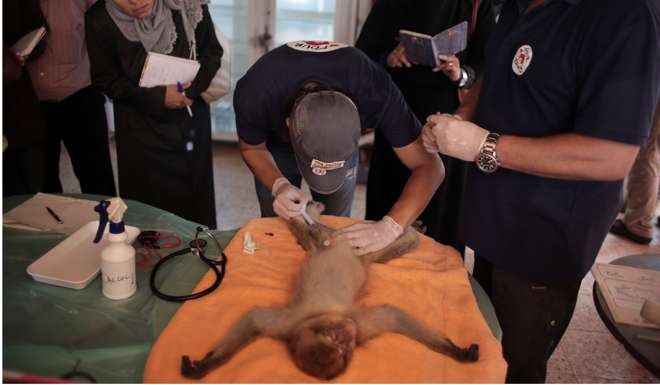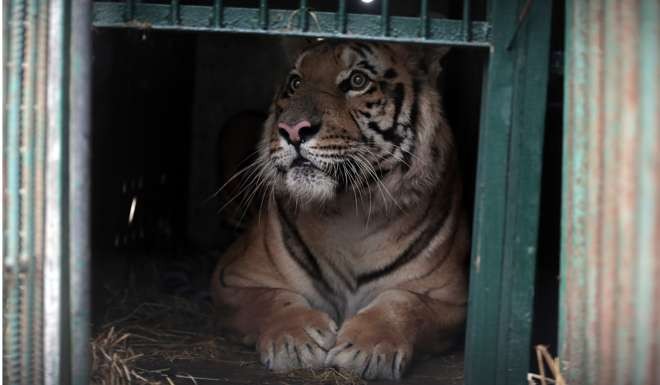Laziz, the last tiger in Gaza, has left the ‘world’s worst zoo’ and is bound for a new life in South Africa

The last tiger in Gaza departed the coastal enclave at dawn on Wednesday, travelling in a wooden crate, cooled by chunks of ice placed on top of his temporary transport.
The tiger was high, perhaps thankfully.
He was given a sedative by his new keepers to help him deal with the strangeness of his trip.
The Bengal tiger was rescued from a painfully small cage here in the now-shuttered amusement park dubbed by animal rights advocates “the worst zoo in the world.”
Truth be told, there are probably worse. It is a big world and there are many miserable zoos.
But the Khan Younis facility was unique. Its owner displayed the mummified corpses of animals that had died at his zoo of stress, disease and starvation.
The last tiger in Gaza, renamed Laziz, meaning “delicious” in Arabic, passed from the besieged Gaza Strip into Israel at the Erez crossing early Wednesday. He wvisited Hebrew University’s Koret veterinary hospital and then continued on to Ben Gurion Airport to make El Al’s evening Flight 71 to Johannesburg.
Laziz was traveling with 14 fellow survivors of the Khan Younis zoo. These were the lucky ones - out of 220 inhabitants at the zoo during its peak.

There was a mother deer, too. She had lost her fawn, which died of wounds sustained struggling to escape her cage a few weeks ago. And an emu, which finally went into his shipping crate after putting up a fight.
The last to be loaded on the truck Tuesday night was the 180kg tiger.
As the animals were being subdued and put into their crates, the local Palestinians at the zoo joked that they would be happy to trade places to get out of Gaza, which suffers from a partial trade and travel blockade, enforced by Israel and Egypt.

Passersby peered into the truck and tried to capture images on their smartphones.
The tiger has lived an impossible life.
The zoo’s owner and patriarch, Ziad Awaida, said he purchased two tiger cubs from black-market traders providing animals for an Egyptian zoo. The cubs, Awaida said in an interview, were smuggled into Egypt from Senegal. For the flight and to pass Egyptian customs, they were disguised as ordinary house cats.
“They painted them black to cover the stripes,” Awaida said. He admits this is an incredible detail. “This is what I was told.”
Where the tigers were born, Awaida said, he does not know. When he bought them in Egypt in 2007, they were still nursing on milk.
The tigers were smuggled into Gaza through the tunnels from the frontier town of Rafah. This may sound extraordinary, too, until you learn that the tunnels are also used to smuggle Mercedes-Benz sedans, orders of Kentucky Fried Chicken and Grad rockets from Iran.
The tigers grew up in their cage in Khan Younis and were the zoo’s most popular attraction. Tickets to enter the park cost US$0.50 for children, almost US$1 for adults.
The pair survived wars in 2008 and 2012 between Israel and Hamas, the Islamist militant organization that controls the Gaza Strip. In the aftermath of the third and most costly war in the summer of 2014, the female tiger died - along with more than 2,100 Palestinians and 72 Israelis.
Awaida said he could not reach the zoo for 17 days because of the shelling and airstrikes from Israel and rocket and mortar attacks by Hamas. Many animals died during the conflict and afterward.
The zoo owner used his rudimentary taxidermy skills, along with formaldehyde and sawdust, to mummify the dead and display them. In addition to the tiger, visitors could look at desiccated carcasses of a baboon, lion and crocodile, and the scattered skeletons of other animals.
The zookeeper’s morbid display was both a financial and political decision. He had bought the animals, and people would pay to see them, dead or alive; he also wanted to show Palestinians what the Gaza wars and Israeli siege had wrought.
What will happen to the animals now? The zoo is closed. The Four Paws group is transporting the birds, deer and porcupines to animal reserves in Jordan.
The tiger is headed to Lionsrock, a big cat preserve in South Africa, where he will be free to roam a large natural enclosure. He is 8 or 9 years old. Tigers in the wild live around 17 years but those in captivity can survive longer, so maybe the story ends well for him.
“He will have a good life in Africa,” promised Amir Khalil, a veterinarian for Four Paws.